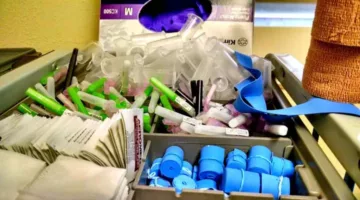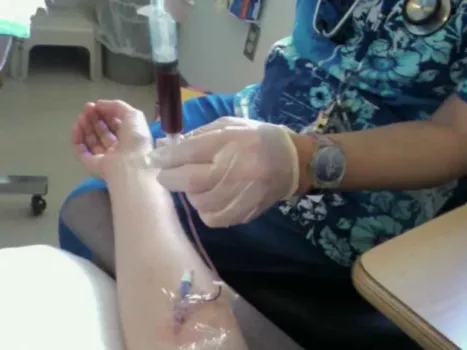
Has your doctor signed you up for blood work and you don’t know what to expect?
Well, it’s no walk in the park on a crisp, colorful fall afternoon. But it’s definitely not as bad as getting a root canal either!
Whenever I get my annual physical, I also have to get my blood work done. This is how the doctor and his aides find out about the overall state of my internal health.
Getting a blood test is a significant part of undergoing a physical, and it’s one reason why a lot of people don’t go to the doctor.
Many are afraid of needles, fear contracting an illness from being punctured by a needle, or think they’ll risk losing a lot of blood if they get poked.
Did You Know?… The fear of needles is called Trypanophobia.
I went nearly 20 years without getting poked by a needle — a streak that ended in 2008 when I was 27 years old and had to get blood work performed before enrolling in a new insurance policy.
Like many folks, I also had an adulthood fear of needles before getting my blood drawn for the first time.
Since then, I’ve become something of an old pro at getting blood drawn.
Here’s what it’s like getting a blood test and what you can expect when you go to your doctor for blood work…
What It’s Like Getting Blood Drawn
So the time has come for your blood test. If you’re wondering exactly what it’s like getting blood drawn, here’s what you can expect:
#1 – In most cases, you’ll be seated in a chair and have your blood pressure, body temperature, and pulse oximetry (that little electronic device a nurse will clip onto your forefinger) checked before the blood draw.
#2 – The blood collection usually begins with prepping the site where the needle will be inserted. On most people, blood is typically collected from some place on the arm or wrist. There are also other places on your body where a phlebotomist can inject a needle for a blood draw.
#3 – Once they’ve identified where your blood will be drawn, the phlebotomist will then rub alcohol on the site to kill any bacteria at and near the site. This step helps prevent spoiling the blood sample with outside germs and also keeps bacteria from entering the body at the injection site.
#4 – After the alcohol has dried (that takes just a few seconds), the nurse will draw the needle. These come in different sizes, with smaller ones suitable for smaller veins and larger ones designed for larger veins.
#5 – If the needle is being inserted into your arm (which is the most likely scenario), the phlebotomist may place a small tourniquet-like band around your upper arm to help bring up the vein and also reduce the risk of excess bleeding.

#6 – By this point in the procedure, the phlebotomist will unwrap the needle from its protective outer wrapping and have it poised in his or her hand for collecting blood.
#7 – The insertion of the needle is a relatively quick procedure accompanied by a pinch-like or stinging sensation. Once the needle is under your skin, you’ll likely feel a very minor sensation that settles after a few moments.
#8 – Depending on how many vials of blood are being drawn and the presence of minor complications (like not getting a good blood return), the needle may be left in for anywhere from 30 seconds to a couple minutes. Most of my blood draws have lasted between 45 seconds and 75 seconds.
#9 – Once your blood has been drawn and the sample collected, the phlebotomist will remove the needle and place a small cotton swab directly on top of the injection site. The cotton will probably be taped down to absorb any residual blood and help the site clot.
For the record, you should feel little or no pain at the injection site. If pain persists for hours after the blood work, the injection site becomes inflamed, or you won’t stop bleeding, you should call your doctor or emergency room at once.
My 5 Best Tips Before Having Your Blood Drawn
Getting blood work done doesn’t have to be very painful. In fact, there are a few ways you can make getting your blood drawn a breeze.
These are tips I used when getting my first blood draw in nearly 20 years, and now I use them virtually every time I go for blood work. Maybe they’ll help you cope with having your blood drawn, too.

- Find out if you need to fast ahead of time — Blood tests involving cholesterol and glucose checks will require you to fast for 12 to 24 hours before the blood draw. Find out if you need to fast before getting your blood drawn, because the last thing you’ll want happening is having to go back in for another injection!
- Drink lots of water — If you’re fasting for your blood draw, you’ll need to avoid dehydration. Thankfully, drinking water is normally permitted, even during a medical fast. Nurses tell me that drinking more water prior to a blood test makes the veins easier to work with and getting a better blood return, minimizing discomfort during the draw.
- Relax — Your phlebotomist is trained to do blood draws and has probably performed thousands in his or her career. Take a deep breath and stay calm. I usually close my eyes and visualize something peaceful to help keep myself calm. Staying serene during the blood collection can make the test go more smoothly and can even help reduce physical discomfort.
- Follow directions — It’ll make things easier for you (and your phlebotomist). To make sure the blood test goes correctly, your phlebotomist will probably instruct you to do certain things just before, during, and immediately after the blood test. These instructions may include squeezing a ball with the hand on the arm used for the collection, breathing calmly, or pressing the cotton swab over the needle site.
- Eat afterwards — If you need to fast before the blood draw, you’re going to be very hungry after the blood test is done and your fast is over. Eat a healthy meal right after your doctor’s visit and relax. The blood draw is over — you’ve survived. Good luck with the results!
More Tips For Getting Blood Drawn
In addition to the links I’ve included above, here are some other resources that will help if you’re still nervous about having blood work done:




